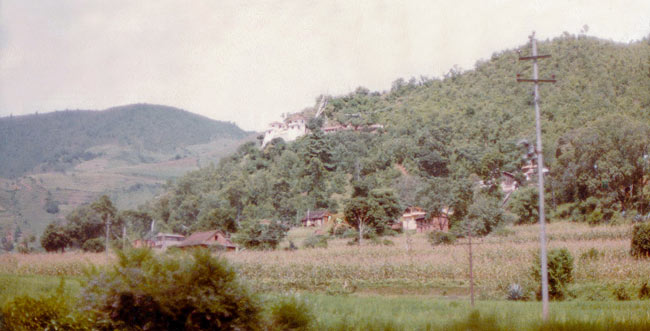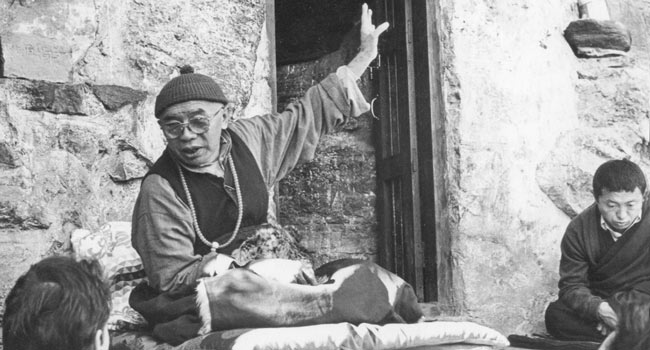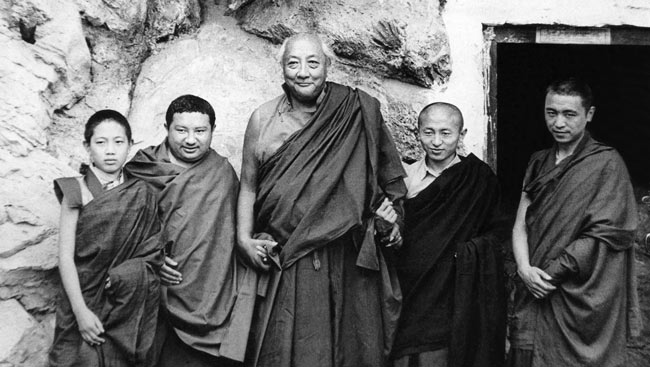History
The Sacred Site of Asura

Located to the south of Kathmandu, the village of Pharping is a well-known place of pilgrimage for the devotees of Vajrayana Buddhism, because it is the site of two caves associated with Padmasambhava. This Indian master who first brought Buddhist tantra to Tibet is said to have meditated and achieved a high level of spiritual accomplishment in these caves.
The cave known as Yangleshö is situated above the Shesh Narayan temple along the road approaching the Pharping bazar, while the Asura cave, the site of Ka-Nying Shedrub Ling’s retreat center, is on the ridge to the west of the town. The biographies of Padmasambhava explain that the master meditated for many years in these caves, practicing the tantric deities Viśuddhaheruka (Tib. yang dag he ru ka) and Vajrakīlaya. In doing so, he also demonstrated the accomplishment of a level of spiritual attainment known as Mahāmudrā Vidyādhara, the third of four such Vidyādhara levels of attainment described in Buddhist tantras.
The cave of Asura is also known as ‘Upper Yangleshö’ or ‘the secluded hermitage of Yangleshö,’ as is mentioned in The Wish-Fulfilling Tree, a biography of Guru Padmasambhava that was revealed by Chokgyur Lingpa:
In the upper practice cave of Yangleshö,
In order to attain the siddhi of the Great Seal,
I performed the practice of The Supreme Glorious Heruka.
Hindrances occurred, inflicting pain upon India and Nepal,
And so I asked my masters to send me teachings methods to repel them.
The messengers carried back the Sublime Knowledge of Kilaya.
By its mere arrival in Nepal, all hindrances were quelled
And I achieved the highest siddhi of the Great Seal.
(The Great Tertön: The Life and Activities of Chokgyur Lingpa, pg. 19)
It is also widely believed that the two caves are connected via a small tunnel. Kyabje Tulku Urgyen Rinpoche mentions this in his book Rainbow Painting:
In the innermost recesses of the Asura Cave at Pharping in the Kathmandu Valley is a tunnel that connects this cave to the Yangleshö Cave down below, about half a mile away. It is not a big hole. Wind passes through this passage and you can feel the draft when sitting near it. Although Padmasambhava could traverse freely through solid matter, he used this narrow tunnel to move between Yangleshö Cave and the upper Asura Cave. When we were restoring the cave a few years ago, the caretaker discovered that hole out through which the wind blew. He said, “Padmashambhava is supposed to have traveled through this tunnel, but it’s so narrow that only a rat or an insect could get through it. Maybe Padmasambhava was that size!” (Rainbow Painting, pg. 177)
Many biographies and revealed tantras (termas) also explain that Guru Padmasambhava bound under oath certain worldly spirits at Asura cave in order that they protect the Buddhist teachings. The Five Chronicles revealed by Orgyen Lingpa explains how Padmasambhava bound under oath the twelve protector deities associated with Vajrakilaya. Furthermore The Dispeller of Obstacles (thugs sgrub bar chad kun sel) revealed by Chokgyur Lingpa is among a number of texts that mentions Asura as the place where Padmasambhava bound the twelve Tenma goddesses under oath to protect the borders of Tibet.
On this side of India, and the far side of Nepal,
In the cave of Asura, Vidyadhara Guru Drapo
Along with Acarya Vasudhara, gave you, the 12 Tenma goddesses,
Permission to participate in their gathering atop a throne,
And gave you the nectar of the Vajrayana commitments.
Pharping appears to have been frequented by Tibetans throughout their travels to Nepal and India spanning many centuries. One of Pharping’s most famous visitors was Marpa Lotsawa (1012-1097), whose 15th century biography by Tsangnyön Heruka records him spending some days in the area performing gaṇacakra pūjās while returning from his third trip to India.
The Asura cave is situated on a ridge approximately 500 meters above Pharping in the jungle to its northwest. At the eastern foot of the hill, there is a Vajrayogini temple, one of four Yogini temples that mark the valley’s four direction (the others being Bijeshwari, Purano Guhyeshwari, and Sankhu’s Khadga Yogini). There is an image of Ganesh and a naturally arisen image of Tara at the bottom of the western staircase.
The cave is known locally as Gorakhnath (i.e., Gorakṣanātha) after the yogi and influential founder of the Nath sect of Hindu monasticism who likely lived in the 11th century. There is a stone representation of his feet, which, according to its inscription, was erected on January 11th, 1391, when Pharping was a feudatory of the powerful King Jayasthiti Malla. Based on other historical evidence, it would appear that the worship of Gorakṣanātha and members of his ascetic order began spreading in Nepal around this time. References to Gorakṣanātha as a Buddhist are also found in lists and biographies of the eighty-four Mahasiddhis of the Vajrayana tradition.
The cave itself contains seven statues. There are three statues of Guru Padmasambhava in the form of Nangsi Silnön and another of Vajrasattva located on the cave uppermost platform. The main statue is Padmasambhava in the form of Tsokye Dorje. It is said that this statue was discovered in a field and brought to the cave by a local Tamang farmer (similar stories exist for many of the images in Nepal). To its left and right are statues of Vajrakīlaya and Viśuddhaheruka, believed by some to have been installed in the cave before the 1950s by a Tibetan from Kham.
There is also a handprint on the exterior of the cave next to the entrance. Some say this is the handprint of an incarnation of Situ Rinpoche, some say it is that of Drubwang Tsoknyi II, while others say it is that of Gorakhnath. Many, however, out of the strength of their faith and devotion, feel that it is clearly the handprint of Guru Rinpoche.
In this way, the caves of Yangleshö and Asura are both of great significance for the followers of Guru Padmasambhava. According to His Holiness Dujom Jigdral Yeshe Dorje and others, these caves are equal in significance to Bodhgaya for practitioners of Vajrayana Buddhism insofar as being the origin and spiritual centre of their respective traditions.
The retreat centre of Pema Ösel Ling

Before officiating the consecration of Ka-Nying Shedrub Ling Monastery in 1976, His Holiness Karmapa Rigpe Dorje had previously once visited Nepal, at which time he requested a long-life empowerment from Kyabje Tulku Urgyen Rinpoche. Rinpoche decided that the Asura cave would be an ideal place for such a ceremony and journeyed there along with Kyabje Chatral Sangye Dorje Rinpoche, Dabzang Rinpoche, Sabchu Rinpoche, Tharig Rinpoche, and Lopön Tsechu Rinpoche. During the empowerment, some excellent signs appeared and the Karmapa requested that, in this place so sacred for the practice of Vajrakilaya, practice and retreat facilities should be constructed. The lamas present, perhaps seeing the difficult cliffside location of the cave, did not immediately give any response. At that moment, the Karmapa explicitly ordered Kyabje Tulku Urgyen Rinpoche to complete the task with the help of Tsechu Rinpoche.
In one of his recorded teachings, Kyabje Tulku Urgyen Rinpoche also relates a story of his being invited to Kyabje Chatral Rinpoche’s retreat center at Yangleshö along with His Holiness Dujom Jikdral Yeshe Dorje Rinpoche. At the time, His Holiness Dujom Rinpoche related a brief explanation of the sacred places of Pharping and commented on how they are equal in stature to Bodhgaya. Later, the lamas went to Shesh Narayan temple where a number of villagers were receiving red tika from the image. A Brahmin woman asked if the lamas would also like to take tika, and His Holiness Dujom Rinpoche enthusiastically accepted. He said that this was a very auspicious sign indicating that the Buddha dharma would flourish in Pharping.
By the late 70s, Tsechu Rinpoche had helped in obtaining permission to use the land from the Rajguthi and a few modest rooms were constructed near the cave. These included two two-story rooms on either side of the cave’s entrance, a row of four rooms to its west and another five rooms to the east. After His Holiness Dilgo Khyentse visited and performed some consecration ceremonies for a period of seven days, the consort of Kyabje Tulku Urgyen Rinpoche, Mayum Kunsang Dechen, began to reside at Asura and remained there until her passing on Apil 24, 1991. She led a life devoted to practice and retreat, completing countless ngöndros, while also educating young monks and nuns in the traditions of the Chokling Tersar and Chöd.
In accord with instructions of the Karmapa and discussions with His Holiness Dilgo Khyentse Rinpoche, Kyabje Tulku Urgyen Rinpoche intended to develop a retreat center focused on preserving the practices of the Chokling Tersar. Thus, starting from about 1980, groups of lamas began three year retreats in which they meditated on the three roots and completion stage practices derived from the Tersar. Initially, because of the lack of facilities and difficulty in bringing water up the hill, retreats were not strictly secluded. Yet with various lamas taking turns, retreats have continued uninterrupted until the present tenth retreat sessions (starting in 2017).
Although Kyabje Tulku Urgyen Rinpoche had first thought that perhaps only a modest number of rooms could be built in a place with such difficult geography, with the encouragement of Mayum Kunsang Dechen, a large temple below the cave was constructed in the mid-80s. The temple features some fine wall paintings along with statues of Shakyamuni Buddha, Tara, and Guru Rinpoche that were produced by Bhutanese artisans under the guidance of Kyabje Tulku Urgyen Rinpoche.
Although this new addition also had a number of retreat rooms, they were still few in number and not fully secluded. For this reason, groups of monks from Ka-Nying Shedrub Ling Monastery stayed in retreat at Nagi gompa during the late eighties and from 1992-1995. Some modifications were made to the building in 1996, allowing for the first group of monks to stay in a fully secluded retreat starting just after the passing of Kyabje Tulku Urgyen Rinpoche. In 2000, the building was again modified to include many more rooms with improved facilities.
In the later 2000s, construction began on the building to the east, and then the building to the west. A new small temple, a hall with a mani wheel, and a place for dharma teachings were added along with extra rooms for monks, nuns, and outside individuals to practice and stay in retreat. Starting in 2009, Chokyi Nyima Rinpoche began holding the fall seminar retreat that at Asura, along with other teachings for Nepalis, monks and nuns, and international students. In this way Asura has become an active place for retreat, pilgrimage, teachings, and puja.
The sangha of the Asura monastery is essentially twofold: one is the group of monks, ranging in number from 5 to 15, who otherwise reside at Ka-Nying Shedrub Ling Monastery, but have come to participate in the three-year retreat. For further information about the nature of these retreats, please click here. {Link to Retreat section of KNSL}. The other section of the sangha consists of monks and nuns fully dedicated to meditation and practice, but do not necessarily stay under conditions of strict seclusion. Many of these practitioners are elderly individuals. They also perform regular pujas and conduct various ceremonies as needed.
Over the years, many highly respected lamas have stayed and practiced at Asura for various lengths of time. Kyabje Tulku Urgyen Rinpoche himself stayed many strict retreats in a room near the cave, often lasting a number of months. Similarly, Khenpo Petse, Namkhai Norbu Rinpoche, Tarthang Tulku, Sogyal Rinpoche and many others have also practiced at Asura. A number of drubchens, hundred-thousand feast offerings, and Vajrakilaya pujas have also been held in the temple over the years.
Notably, Khenpo Jigme Phuntsok also visited Asura in 1990 where he stayed for a number of days. He revealed a terma text from the cave that is a sadhana of Vajrakilaya (phur pa mgul khug ma’i cha shas thugs dam thugs kyi phur gcig). It was later officially recorded by the Dalai Lama. This information can be found in his collected works.
